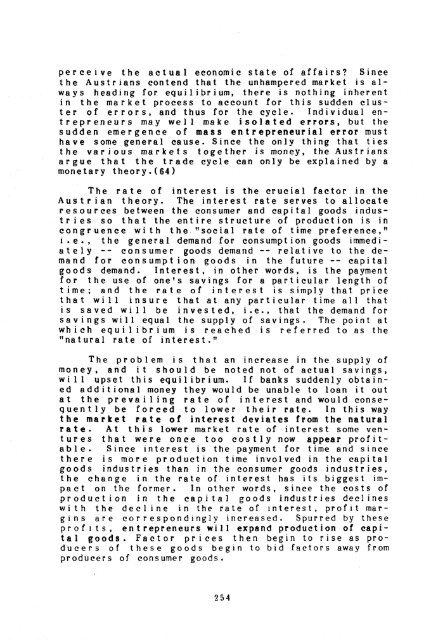Freedom, Society, and State - Ludwig von Mises Institute
Freedom, Society, and State - Ludwig von Mises Institute
Freedom, Society, and State - Ludwig von Mises Institute
Create successful ePaper yourself
Turn your PDF publications into a flip-book with our unique Google optimized e-Paper software.
per c e i vet h e act u 8 1 e conom i cstate 0 f a f fa irs? Sin c e<br />
the Austrians contend that the unhampered market is alwayshea<br />
dj ng for equi 1 i b I' i urn, the I' e i s not h i nginher en t<br />
in the market process to account for this sudden cluster<br />
of errors, <strong>and</strong> thus for the cycle. Individual entrepreneurs<br />
may well make isolated errors, but the<br />
sudden emergence of mass entrepreneurial error must<br />
have some general cause. Since the only thing that ties<br />
the va rio u s rnark e t s tog e the I' i s rno ne y, the Au s t ria n s<br />
argue that the trade cycle can only be explained by a<br />
monetary theory.(64)<br />
The rate of interest is the crucial factor in the<br />
Austr ian theory. The interest rate serves to allocate<br />
resources between the consumer <strong>and</strong> capital goods industr<br />
ies so that the entire structure of production is in<br />
congruence wi th the. "social rate of time preference,"<br />
i. e., the general dem<strong>and</strong> for consumpt ion goods immediately<br />
-- consumer goods dem<strong>and</strong> -- relative to the dem<strong>and</strong><br />
for consumption goods in the future -- capital<br />
goods dem<strong>and</strong>. Interest, in other words, is the payment<br />
for the use of one's savings for a particular length of<br />
time; <strong>and</strong> the rate of interest is simply that price<br />
that will insure that at any particular time all that<br />
iss a v e d will be i n ve s ted, i. e ., t hat the dema nd for<br />
sa vi ngs wi 11 equal the supply of savings. The point at<br />
which equilibrium is reached is referred to as the<br />
"natural rate of interest."<br />
The problem is that an increase in the supply of<br />
money, <strong>and</strong> it should be noted not of actual savings,<br />
wi 11 upset this equil ibrium. If banks suddenly obtained<br />
additional money they would be unable to loan it out<br />
at the prevailing rate of interest <strong>and</strong> would conseque<br />
n t 1Y be for cedt 0 lower the i r rat e • In t his wa y<br />
the ma I' k e t I' ate 0 fin tel'est dev i ates from the nat ur a 1<br />
rate. At this lower market rate of interest some ventures<br />
that were once too costly now appear profitable.<br />
Since interest is the payment for time <strong>and</strong> since<br />
there is more production time involved in the capital<br />
goods industries than in the consumer goods industries,<br />
the change in the rate of interest has its biggest impact<br />
on the former. In other words, since the costs of<br />
production in the capital goods industries declines<br />
wit h the dec 1 i n e i ntherateofin t ere s t, pI' 0 fit rna rgins<br />
are correspondingly increased. Spurred by these<br />
profIts, entrepreneurs will exp<strong>and</strong> production of capital<br />
goods. Factor pI' ices then begin to rise as producers<br />
of these goods begin to bid factors away from<br />
producers of consumer goods.<br />
254
















